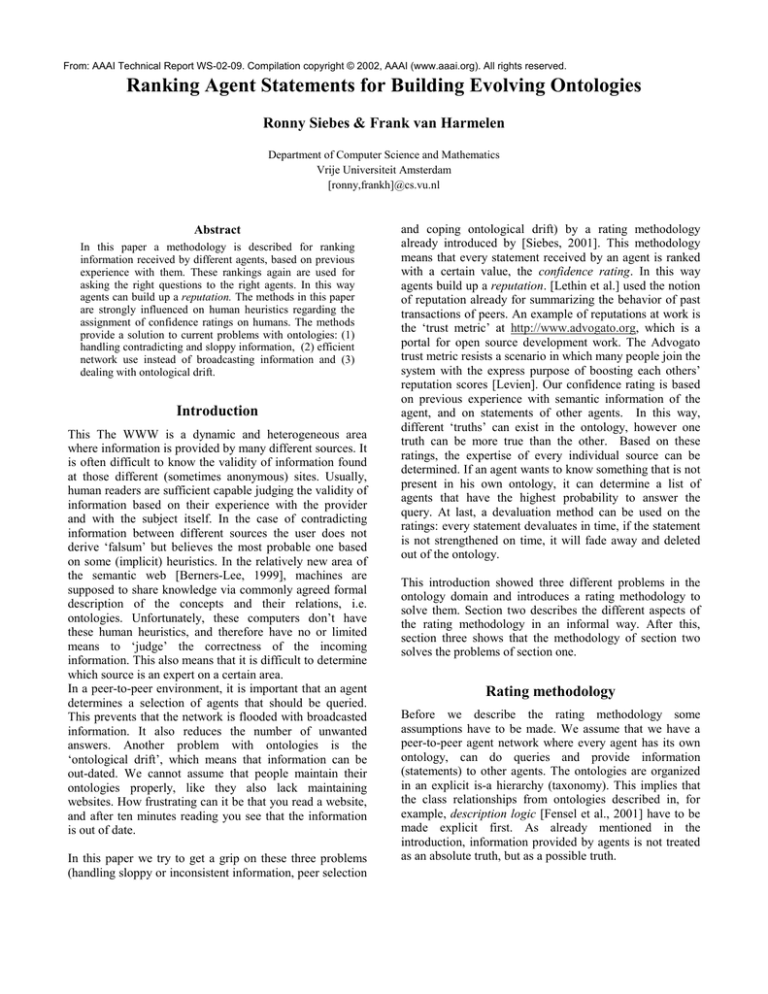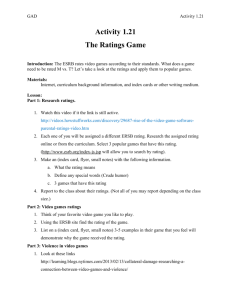
From: AAAI Technical Report WS-02-09. Compilation copyright © 2002, AAAI (www.aaai.org). All rights reserved.
Ranking Agent Statements for Building Evolving Ontologies
Ronny Siebes & Frank van Harmelen
Department of Computer Science and Mathematics
Vrije Universiteit Amsterdam
[ronny,frankh]@cs.vu.nl
Abstract
In this paper a methodology is described for ranking
information received by different agents, based on previous
experience with them. These rankings again are used for
asking the right questions to the right agents. In this way
agents can build up a reputation. The methods in this paper
are strongly influenced on human heuristics regarding the
assignment of confidence ratings on humans. The methods
provide a solution to current problems with ontologies: (1)
handling contradicting and sloppy information, (2) efficient
network use instead of broadcasting information and (3)
dealing with ontological drift.
Introduction
This The WWW is a dynamic and heterogeneous area
where information is provided by many different sources. It
is often difficult to know the validity of information found
at those different (sometimes anonymous) sites. Usually,
human readers are sufficient capable judging the validity of
information based on their experience with the provider
and with the subject itself. In the case of contradicting
information between different sources the user does not
derive ‘falsum’ but believes the most probable one based
on some (implicit) heuristics. In the relatively new area of
the semantic web [Berners-Lee, 1999], machines are
supposed to share knowledge via commonly agreed formal
description of the concepts and their relations, i.e.
ontologies. Unfortunately, these computers don’t have
these human heuristics, and therefore have no or limited
means to ‘judge’ the correctness of the incoming
information. This also means that it is difficult to determine
which source is an expert on a certain area.
In a peer-to-peer environment, it is important that an agent
determines a selection of agents that should be queried.
This prevents that the network is flooded with broadcasted
information. It also reduces the number of unwanted
answers. Another problem with ontologies is the
‘ontological drift’, which means that information can be
out-dated. We cannot assume that people maintain their
ontologies properly, like they also lack maintaining
websites. How frustrating can it be that you read a website,
and after ten minutes reading you see that the information
is out of date.
In this paper we try to get a grip on these three problems
(handling sloppy or inconsistent information, peer selection
and coping ontological drift) by a rating methodology
already introduced by [Siebes, 2001]. This methodology
means that every statement received by an agent is ranked
with a certain value, the confidence rating. In this way
agents build up a reputation. [Lethin et al.] used the notion
of reputation already for summarizing the behavior of past
transactions of peers. An example of reputations at work is
the ‘trust metric’ at http://www.advogato.org, which is a
portal for open source development work. The Advogato
trust metric resists a scenario in which many people join the
system with the express purpose of boosting each others’
reputation scores [Levien]. Our confidence rating is based
on previous experience with semantic information of the
agent, and on statements of other agents. In this way,
different ‘truths’ can exist in the ontology, however one
truth can be more true than the other. Based on these
ratings, the expertise of every individual source can be
determined. If an agent wants to know something that is not
present in his own ontology, it can determine a list of
agents that have the highest probability to answer the
query. At last, a devaluation method can be used on the
ratings: every statement devaluates in time, if the statement
is not strengthened on time, it will fade away and deleted
out of the ontology.
This introduction showed three different problems in the
ontology domain and introduces a rating methodology to
solve them. Section two describes the different aspects of
the rating methodology in an informal way. After this,
section three shows that the methodology of section two
solves the problems of section one.
Rating methodology
Before we describe the rating methodology some
assumptions have to be made. We assume that we have a
peer-to-peer agent network where every agent has its own
ontology, can do queries and provide information
(statements) to other agents. The ontologies are organized
in an explicit is-a hierarchy (taxonomy). This implies that
the class relationships from ontologies described in, for
example, description logic [Fensel et al., 2001] have to be
made explicit first. As already mentioned in the
introduction, information provided by agents is not treated
as an absolute truth, but as a possible truth.
The rating methodology involves the following aspects: (1)
assigning confidence ratings on statements received by
agents. (2) Updating these ratings when new information
comes into the ontology. (3) Using these ratings to
determine the appropriate expert for answering an
incoming query that can’t by answered by the agent itself.
(4) Updating the assumptions made by determining the
experts. (5) Applying an aging mechanism on ratings and
removing statements that dropped below a certain value.
We now describe these aspects in more detail:
Assigning confidence ratings
When a statement is provided by an unknown source it gets
a (low) initial confidence rating. With ‘unknown’ we mean
that the source never has provided any information to the
receiver. Thus, when an agent a receives information from
agent b and b is unknown to a, then the receiving agent has
to decide if it includes the information of b into the
ontology. If it wants to include this, and it has no clue
about the reputation of b, it assigns an initial confidence to
the information.
Updating confidence ratings
If other agents than the original sender repeat an existing
statement, the statement gains higher confidence. This has
the side effect that also the source of the existing statement
becomes more an expert on the relevant concept and those
close to it. To determine the ‘closeness’ of concepts
towards each other we use the notion of semantic distance
[Budanitsky]. How this works, will be explained in section
three.
Determining the experts to be queried
If an agent receives a query (from a user, or another agent)
and it cannot answer this query out of its ontology, it
calculates a list of agents that have the highest probability
to give a correct answer. Also here the semantic distance is
of big importance: not only the reputation of the agents is
important, but also the closeness of its expertise to the
query.
qc
<
<ec
< <
ec
-
ec
decrease the ‘expert range’ of the expert.
qc
before
ec
ec
ec
after
The choice between the first and the second option depends
on the maturity of the ontology. If an is-a relation just was
formed, the weight between the two classes is less fixed
than in the case when relation survived already for a long
time. Thus, the longer the is-a relations exist the more
difficult it is to adapt the weight, and the more the expert
range is of influence.
Aging mechanism to devaluate confidence ratings in time
An aging mechanism takes care of the obsolete statements.
In time the confidence ratings devaluate, and if they drop
below a certain treshold, the statement will be deleted. The
only way to stay alive is that these statements are repeated
now and then. In this way only the ‘strong’ statements will
survive. This basic strategy can at least be extended with
two enhancements:
1.
Statements that survived for a long time are less
influenced by the aging mechanism as ‘fresh’
statements.
If a statement survived already for a long time, it is
probably a statement that is always true, i.e. it is
independent from time. For example, “Bach is-a
musician”, or water is wet.
2.
Statements higher in the tree are less influenced by the
aging mechanism, then statements at the leaves.
Statements high in the ontology tree are more general
then those at the leaves. General statements are often
so trivial that almost nobody makes them explicit, e.g.
“a car has wheels” or “an animal is-a living_creature”.
To ‘protect’ these general statements, the aging
Updating assumptions made about determining the experts
If an agent, selected as an expert from the list above,
answers with ‘I don’t know!’, a wrong assumption is made
about the expertise of the agent. Now we have two
possibilities:
increase the semantic distance between the concept in
the query qc and the concepts of the expert ec.
3.
mechanism is not as tough then on the more specific
statements.
Proceedings of PAAM'99, London,
1999.
Distinguish different statement types in applying the
aging mechanism.
There is a difference between absolute statements like
“the speed of the HP880cxi printer is 12 ppm” and
relative statements like “the speed of the HP880cxi
printer is high”. When a distinction is made in the
ontology between those statements, we can use this
knowledge to examine which statements are more
influenced by time.
[Berners-Lee, 1999]
Berners-Lee T. Weaving the Web. Harper, San Francisco,
1999.
A positive side-affect of the aging mechanism, is its
prevention of the inflate effect on increasing confidence
ratings (experiments should fine-tune the mechanism). This
side effect is needed because for now we only increase the
ratings in case of confirmation of other agents, we don’t
decrease the ratings if agents say the opposite. The reason
for this is the difficulty in finding opposite statements, e.g.
the system should know that a person can’t be a woman and
a man, in order to determine that man(x) is the opposite of
woman(x).
Conclusions
Now that we described the rating methodology, we will
explain how it solves the three problems as described in the
introduction. First, the rating methodology handles sloppy
and contradicting information by adding ratings to
statements. In case of two inconsistent statements the
system can choose the most probable answer instead of
deriving falsum. Second, an efficient peer selection method
is introduced by selecting agents on their assumed
expertise. Only ask those agents that have the highest
probability to answer your query correctly. Third, the rating
method deals with ontological drift by automatically
degrading the ratings. If a statement is not strengthened in
time, it will fade out of the network. In this way only the
strong and the new statements reside in the ontology.
The rating method as here described contains a lot of
parameters that have to be tuned in practice, therefore we
started with implementing a system to do this. It will be a
combination with the Protégé ontology editor [Noy et al.,
2000] and the JADE agent platform [Bellifemine et al.,
1999].
References
[Bellifemine et al., 1999]
Bellifemine F., Poggi, A., Rimassa, G. JADE – A FIPAcompliant agent framework CSELT internal technical
report. Part of this report has been also published in
pag. 97-108, April
[Budanitsky et al., 2001]
Budanitsky A., Hirst G. Semantic distance in WordNet: An
experimental, application-oriented evaluation of five
measures. Workshop on WordNet and Other Lexical
Resources, Second meeting of the North American Chapter
of the Association for Computational Linguistics,
Pittsburgh, June 2001.
[Fensel et al., 2001]
Fensel D., Horrocks I., Harmelen van F., McGuinness, D.
and Patel-Schneider D.: OIL: Ontology Infrastructure to
Enable the Semantic Web, IEEE Intelligent System, 16(2),
2001.
[Lethin et al., 2001]
Lethin, R. Peer-to-peer: Harnessing the power of
disruptive technologies. O’Reilly ISBN 0-596-00110-x,
March 2001.
[Levien]
Levien
R.
Advogato’s
Trust
http://www.advogato.org/trust-metric.html
Metric.
[Noy et al., 2000]
Noy N., Fergerson R., Musen M. The knowledge model of
Protege-2000: Combining interoperability and flexibility.
2th International Conference on Knowledge Engineering
and Knowledge Management (EKAW'2000), Juan-les-Pins,
France, 2000.
[Siebes, 2001]
Siebes, R. LARiSSA: A prototype implementation of
evolving ontologies. Masters’ thesis, Vrije Universiteit
Amsterdam, August 2001.





